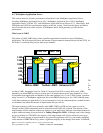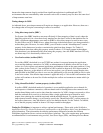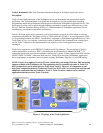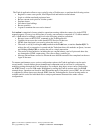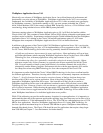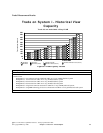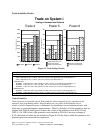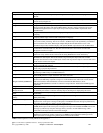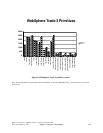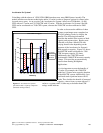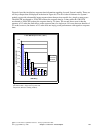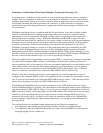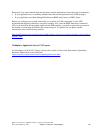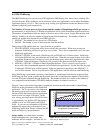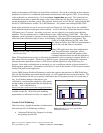
PingServlet2TwoPhase drives a Session EJB which invokes an Entity EJB with findByPrimaryKey
(DB Access) followed by posting a message to an MDB through a JMS Queue (Message access).
These operations are wrapped in a global 2-phase transaction and commit.
PingServlet2TwoPhase
PingServlet2MDBTopic drives messages to a Topic based Publish/Subscribe Message Driven EJB
(MDB).Each request to the servlet posts a message to the Topic. The TradeStreamMDB receives the
message asynchronously and
prints message delivery statistics on each 100th message. Other
subscribers to the Topic will also receive the messages.
PingServlet2MDBTopic
PingServlet2MDBQueue drives messages to a Queue based Message Driven EJB (MDB).Each
request to the servlet posts a message to the Queue. The MDB receives the message asynchronously
and prints message delivery statistics on each 100th message.
PingServlet2MDBQueue
This test drives an Entity EJB to get another Entity EJB's data through an EJB 2.0 CMR One to
Many relationship
PingServlet2Session2CMROne
2Many
This test drives an Entity EJB to get another Entity EJB's data through an EJB 2.0 CMR One to One
relationship
PingServlet2Session2CMROne
2One
This test extends the previous EJB Entity test by calling a Session EJB which uses a finder method
on the Entity that returns a collection of Entity objects. Each object is displayed by the servlet
PingServlet2Session2
EntityCollection
Tests the full servlet to Session EJB to Entity EJB path to retrieve a single row from the database.PingServlet2Session2Entity
PingServlet2EntityEJB tests key function of a servlet call to an EJB 2.0 Container Managed Entity.
In this test the EJB entity represents a single row in the database table. The Local version uses the
EJB Local interface while the Remote version uses the Remote EJB interface. (Note:
PingServlet2EntityEJBLocal will fail in a multi-tier setup where the Trade3 Web and EJB apps are
seperated.)
PingServlet2EntityEJBLocal
PingServlet2EntityEJBRemote
PingServlet2SessionEJB tests key function of a servlet call to a stateless SessionEJB. The
SessionEJB performs a simple calculation and returns the result.
PingServlet2SessionEJB
PingServlet2JNDI tests the fundamental J2EE operation of a servlet allocating a JNDI context and
performing a JNDI lookup of a JDBC DataSource.
PingServlet2JNDI
PingJDBCRead tests fundamental servlet to JDBC access to a database performing a single-row
write using a prepared SQL statment.
PingJDBCWrite
PingJDBCRead tests fundamental servlet to JDBC access to a database performing a single-row read
using a prepared SQL statment.
PingJDBCRead
PingHTTPSession3 large session object tests the servers ability to manage and persist large
HTTPSession data objects. The servlet creates a large custom java object. The class contains
multiple data fields and results in 2048 bytes of data. This large session object is retrieved and stored
to the session on each user request.
PingHTTPSession3
PingHTTPSession2 session create/destroy further extends the previous test by invalidating the HTTP
Session on every 5th user access. This results in testing HTTPSession create and destroy.
PingHTTPSession2
PingHTTPSession1 - SessionID tests fundamental HTTP session function by creating a unique
session ID for each individual user. The ID is stored in the users session and is accessed and
displayed on each user request.
PingHTTPSession1
PingServlet2JSP tests a commonly used design pattern, where a request is issued to servlet providing
server side control processing. The servlet creates a JavaBean object with dynamically set attributes
and forwards the bean to the JSP through a RequestDispatcher The JSP obtains access to the
JavaBean and provides formatted display with dynamic HTML output based on the JavaBean data.
PingServlet2JSP
PingJSPEL tests a direct call to JavaServer Page providing server-side dynamic HTML through JSP
scripting and the usage of the new JSP 2.0 Expression Language.
PingJSPEL
PingJSP tests a direct call to JavaServer Page providing server-side dynamic HTML through JSP
scripting.
PingJSP
PingServlet2Servlet tests request dispatching. Servlet 1, the controller, creates a new JavaBean
object forwards the request with the JavaBean added to Servlet 2. Servlet 2 obtains access to the
JavaBean through the Servlet request object and provides dynamic HTML output based on the
JavaBean data.
PingServlet2Servlet
PingServlet2Include tests response inclusion. Servlet 1 includes the response of Servlet 2.PingServlet2Include
PingServletWriter extends PingServlet by using a PrintWriter for formatted output vs. the output
stream used by PingServlet.
PingServletWriter
PingServlet tests fundamental dynamic HTML creation through server side servlet processing.PingServlet
PingHtml is the most basic operation providing access to a simple "Hello World" page of static
HTML.
PingHtml
Description of PrimitivePrimitive Name
Table 6.1 Description of Trade primitives in Figure 6.4
IBM i 6.1 Performance Capabilities Reference - January/April/October 2008
© Copyright IBM Corp. 2008 Chapter 6 - Web Server and WebSphere 101



